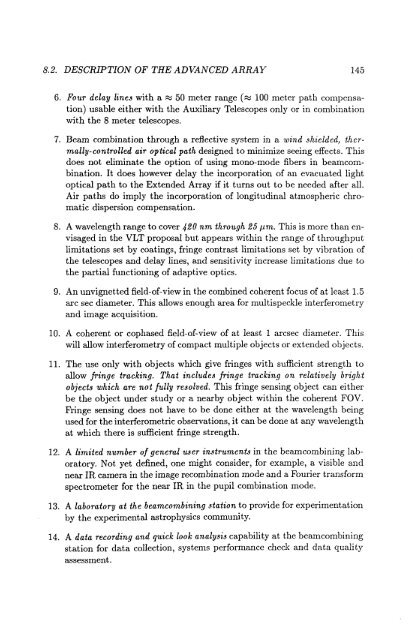The VLT Interferometer - ESO
The VLT Interferometer - ESO
The VLT Interferometer - ESO
You also want an ePaper? Increase the reach of your titles
YUMPU automatically turns print PDFs into web optimized ePapers that Google loves.
8.2. DESCRIPTION OF THE ADVANCED ARRAY 145<br />
6. Four delay lines with a ::::::: 50 meter range (::::::: 100 meter path compensation)<br />
usable either with the Auxiliary Telescopes only or in combination<br />
with the 8 meter telescopes.<br />
7. Beam combination through a reflective system in a wind shielded, thermally-controlled<br />
air optical path designed to minimize seeing effects. This<br />
does not eliminate the option of using mono-mode fibers in beamcombination.<br />
It does however delay the incorporation of an evacuated light<br />
optical path to the Extended Array if it turns out to be needed after all.<br />
Air paths do imply the incorporation of longitudinal atmospheric chromatic<br />
dispersion compensation.<br />
8. A wavelength range to cover 420 nm through 25 pm. This is more than envisaged<br />
in the <strong>VLT</strong> proposal but appears within the range of throughput<br />
limitations set by coatings, fringe contrast limitations set by vibration of<br />
the telescopes and delay lines, and sensitivity increase limitations due to<br />
the partial functioning of adaptive optics.<br />
9. An unvignetted field-of-view in the combined coherent focus of at least 1.5<br />
arc sec diameter. This allows enough area for multispeckle interferometry<br />
and image acquisition.<br />
10. A coherent or cophased field-of-view of at least 1 arcsec diameter. This<br />
will allow interferometry of compact multiple objects or extended objects.<br />
11. <strong>The</strong> use only with objects which give fringes with sufficient strength to<br />
allow fringe tracking. That includes fringe tracking on relatively bright<br />
objects which are not fully resolved. This fringe sensing object can either<br />
be the object under study or a nearby object within the coherent FOV.<br />
Fringe sensing does not have to be done either at the wavelength being<br />
used for the interferometric observations, it can be done at any wavelength<br />
at which there is sufficient fringe strength.<br />
12. A limited number of general user instruments in the beamcombining laboratory.<br />
Not yet defined, one might consider, for example, a visible and<br />
near LR camera in the image recombination mode and a Fourier transform<br />
spectrometer for the near LR in the pupil combination mode.<br />
13. A laboratory at the beamcombining station to provide for experimentation<br />
by the experimental astrophysics community.<br />
14. A data recording and quick look analysis capability at the beamcombining<br />
station for data collection, systems performance check and data quality<br />
assessment.

















